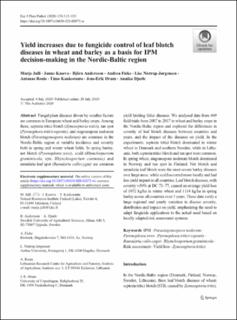| dc.contributor.author | Jalli, Marja | |
| dc.contributor.author | Kaseva, Janne | |
| dc.contributor.author | Andersson, Björn | |
| dc.contributor.author | Ficke, Andrea | |
| dc.contributor.author | Nistrup-Jørgensen, Lise | |
| dc.contributor.author | Ronis, Antanas | |
| dc.contributor.author | Kaukoranta, Timo | |
| dc.contributor.author | Ørum, Jens-Erik | |
| dc.contributor.author | Djurle, Annika | |
| dc.date.accessioned | 2021-03-10T15:32:07Z | |
| dc.date.available | 2021-03-10T15:32:07Z | |
| dc.date.created | 2020-09-09T22:15:47Z | |
| dc.date.issued | 2020-07-28 | |
| dc.identifier.citation | European journal of plant pathology. 2020, 158 315-333. | en_US |
| dc.identifier.issn | 0929-1873 | |
| dc.identifier.uri | https://hdl.handle.net/11250/2732701 | |
| dc.description.abstract | Fungal plant diseases driven by weather factors are common in European wheat and barley crops. Among these, septoria tritici blotch (Zymoseptoria tritici), tan spot (Pyrenophora tritici-repentis), and stagonospora nodorum blotch (Parastagonospora nodorum) are common in the Nordic-Baltic region at variable incidence and severity both in spring and winter wheat fields. In spring barley, net blotch (Pyrenophora teres), scald (Rhynchosporium graminicola, syn. Rhynchosporium commune) and ramularia leaf spot (Ramularia collo-cygni) are common yield limiting foliar diseases. We analysed data from 449 field trials from 2007 to 2017 in wheat and barley crops in the Nordic-Baltic region and explored the differences in severity of leaf blotch diseases between countries and years, and the impact of the diseases on yield. In the experiments, septoria tritici blotch dominated in winter wheat in Denmark and southern Sweden; while in Lithuania, both septoria tritici blotch and tan spot were common. In spring wheat, stagonospora nodorum blotch dominated in Norway and tan spot in Finland. Net blotch and ramularia leaf blotch were the most severe barley diseases over large areas, while scald occurred more locally and had less yield impact in all countries. Leaf blotch diseases, with severity >50% at DC 73–77, caused an average yield loss of 1072 kg/ha in winter wheat and 1114 kg/ha in spring barley across all countries over 5 years. These data verify a large regional and yearly variation in disease severity, distribution and impact on yield, emphasizing the need to adapt fungicide applications to the actual need based on locally adapted risk assessment systems. | en_US |
| dc.language.iso | eng | en_US |
| dc.publisher | Springer Nature | en_US |
| dc.rights | Navngivelse 4.0 Internasjonal | * |
| dc.rights.uri | http://creativecommons.org/licenses/by/4.0/deed.no | * |
| dc.title | Yield increases due to fungicide control of leaf blotch diseases in wheat and barley as a basis for IPM decision-making in the Nordic-Baltic region | en_US |
| dc.type | Peer reviewed | en_US |
| dc.type | Journal article | en_US |
| dc.description.version | publishedVersion | en_US |
| dc.rights.holder | © The Author(s) 2020 | en_US |
| dc.source.pagenumber | 315-333 | en_US |
| dc.source.volume | 158 | en_US |
| dc.source.journal | European journal of plant pathology | en_US |
| dc.identifier.doi | 10.1007/s10658-020-02075-w | |
| dc.identifier.cristin | 1828566 | |
| dc.relation.project | Norges forskningsråd: 273181 | en_US |
| cristin.ispublished | true | |
| cristin.fulltext | original | |
| cristin.qualitycode | 1 | |

